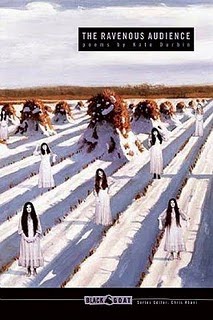'It's not exposure I'm after - it's the bare minimum. I want the world to know the
skin I'm in, for my skin to know this world before it's gone. Flesh is the
most genuine meeting point any of us have got.'
Our Marilyn(s): interview
Kate Durbin's Ravenous Audience isn't just a collection of poetry. With its considered formatting and use of (negative) space it has all the elements of an art installation, spread neatly across the page like a centre-fold. Durbin herself is a performance artist so it should come as no surprise that her poetry, written for and about 'the audience' should lift itself off the page, stand on its hind legs and howl for attention.
The collection is split into four parts, or scenes: Garden Plot, Water Bodies, Flight and Trail of Crumbs, which might be split further into the celluloid, the cautionary and the fantastic. Here are poems of flight and fancy, celebrity, body-image, fairy-tale and physical transformation. There is a lot on offer here, 136 pages in total, though some of those pages are blank except for one or two words, whilst others are compilations of lists, such as the paring down of celebrity, the un-romanticising of the glamorous world of showbiz into lists of clothes, jewels, keepsakes, prescriptions and legal documents in Marilyn, Leftovers.
Also in list form, the description of a scene in From A Real Young Girl:
6) A moan of flies in a dim airless kitchen
7) A fat man in a brown suit, scooping spoonfuls of brown
sugar into a cup of tea
8) A woman with a string of blue beads around her neck,
almost tight enough to cut off her oxygen
Similarly in Statues of Women, All the Same, Durbin gives us a list of women doing (in generalised/stereotypical terms) what women do - dancing, baking, bleeding, laughing:
Women talking in cafes
drinking absinthe
Woman humming a wordless tune
Women laughing behind their fingers
Woman sucking seeds from a pomegranate
Are these film stills? Images from a dream? Advertisements? There are other references to adverts here eg. To the Woman in the 1954 Vogue Magazine Advertisment... Durbin has 'cut up' magazine spreads and film reels the way the media 'cut up' celebrities and re-label their subsequent parts.
'This, our nightly ritual: strip, portion you out...' The Rebirth of Jezebel
None of this is new, of course. The body as prison (on the page, on the screen, beneath the skin, which is merely hide to be prised off and tanned); pounds of flesh sliced and diced and handed out on a platter. But there is no reason not to re-visit old ground if you can make your mark, and Durbin does precisely this. She makes these themes refreshing and allows women the freedom to make their own metamorphoses, often in recurring states of nature.
'Naked in waves. Rolls and rolls. Finally something bigger. The sea
Is always bigger, far wider than flesh.'
Fat Girl
Performance/audience - body (image). This collection is a 'body of art', about the body - in art. Art as in film as in theatre as in spectacle as in transformation. Even (especially) in the porn industry where the body literally is the object. Durbin takes us through the maze of mirrors, where one woman's gaze is another woman's reflection, and into the dark realms of the forest, where everyone is unique but, as in that other world, not everything is as it seems. Masks are worn, claws are temporarily retracted. Little girls are told not to stray from the path, for there are wolves lurking in the shadows and witches waiting by their ovens.
'See the witch in the window watching,
One fingernail tapping her teeth.'
Getel and the Witch
But sometimes the little girl is the witch. And sometimes she is the beast, shed of her clothes, her inhibitions and her self-doubt.
'The moment she stops walking upright, falling spiderlike
To the loam. Creeping forward on all fours, body coated in soil.'
New Creature
Durbin splices lists with adverts with film-stills with poems to create a collage of woman as suspended, objectified being. Her poetry embraces the distinctions of every woman while exposing the every-woman logic at the heart of the culture of 'beauty'. Not every poem in the collection is a diamond, but the poems that are good are very, very good and there are enough of these to make this a damn fine body of art.




